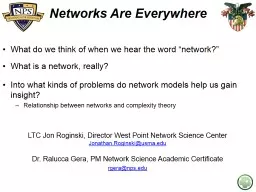

JonathanRoginskiusmaedu Dr Ralucca Gera PM Network Science Academic Certificate rgeranpsedu Networks Are Everywhere What do we think of when we hear the word network What is a network really ID: 647836
Download Presentation The PPT/PDF document "LTC Jon Roginski, Director West Point Ne..." is the property of its rightful owner. Permission is granted to download and print the materials on this web site for personal, non-commercial use only, and to display it on your personal computer provided you do not modify the materials and that you retain all copyright notices contained in the materials. By downloading content from our website, you accept the terms of this agreement.
Slide1
LTC Jon Roginski, Director West Point Network Science CenterJonathan.Roginski@usma.eduDr. Ralucca Gera, PM Network Science Academic Certificatergera@nps.edu
Networks Are Everywhere
What do we think of when we hear the word “network?”
What is a network, really?
Into what kinds of problems do network models help us gain insight?
Relationship between networks and complexity theorySlide2
What is a Network?http://www.opte.org/maps/The Opte Project - visualizing the Internet - Asia: Red; Europe
: Green; North America: Blue; Latin America: Yellow; IPs: Cyan; Unknown
: White
The Internet
Roginski Facebook
https://lostcircles.com
/
Using the Chrome browser, download the plugin and you can see your network, too!
Most people think of these when they think of networks:Slide3
Roginski FacebookMonterey Coffee Group
Bay View Academy
Civilian Analyst Friends – Fort Drum
West Point Classmates
NPS Master’s Degree
USMA Math Department
Fairhaven Family
Watertown Gang
Inlaws
High School Classmates
Blood FamilySlide4
But Wait, There’s More!Let’s list a couple more examples we think of when we think of networks.What structures do they have in common?Entities
Relationships between entitiesData describing the entities and/or relationships
Key difference between graphs and networks
Now, with this expanded understanding of what networks are, let’s list a couple more
G = (V,E)Slide5
But Wait, There’s (still) More!UNCLASSIFIED
Since we were young, what is the technique we most often use to solve big, nasty, complicated problems?
What is the difference between “complicated” and “complex?”
We live in complex times. Complex problems and complex systems resist reductionism and disaggregation. Networks “embrace the complexity” through accounting for connections.
Now that we more fully understand the breadth of what may be appropriately modeled by a network, are there any examples we may have missed?
What can
not
be modeled by a network?
Reality: Networks are the building block of life and our environment.Slide6
Networks: “Flat” or Multilayer?Take the idea of a social network and expand.
When we include the networks associated with each element of an environment, we come closer to characterizing the environment than using one single layer or a simple aggregation of those single layers. What problem are you trying to solve?Slide7
Application: Key Leader Engagements
If I was going to recommend a KLE strategy in this area, it would be with
Zintan #1 and
Qadafa
#2
…those two influence all three layers of the network. If we determine we have the leverage, the
Petroleum Facilities Guards #3
are potentially even more impactful.
1
2
31 nodes
109 edges
3
Arab
Tubu
TauregSlide8
Applications:TargetingA military example, High Payoff Targeting: Why was the network of bad actors largely unaffected even though I removed the (apparently) most important guy from the network?That social network is only a part of the enemy’s ecosystem. We didn’t account for the impact of those other elements on the network’s robustness.Network analysis of the environment lends greater context and texture to the decision making environment, enabling greater detail and predictive power in decision recommendations.Slide9
Applications:Pandemic SpreadPandemic mitigation must account for “effective distance,” rather than geographic distance in today’s connected world.
Dirk
Brockmann
, and Dirk Helbing Science 2013;342:1337-1342Slide10
Applications:Infrastructure DefenseWith 5 edge cuts, 100% of the flow from the ports of LA and Long beach is interdicted. With 2 edge cuts, it’s 40%.Slide11
Applications:Infrastructure DefenseThough there may not be a single “cut” in a network, interdiction sets of differing sizes may achieve the desired effects of reducing flow.
Alderson, D. L., Brown, G. G., Carlyle, W. M., & Cox Jr, L. A. (2013).
Sometimes there is no most-vital arc: assessing and improving the operational resilience of systems
. Military Operations Research, V18 N1 2013,
doi
10.5711/1082598318121Slide12
Networks and ObesityObesity clusters in children’s and adults social networks.Having a social connection who is obese predicts obesity.https://www.coursera.org/learn/systems-science-obesity/lecture/92Q5g/obesity-social-networksSlide13
Application: Job HuntingOne of the vertices is the only one that has connections to three communities.Three times “more important” than the next highest vertex.Roginski LinkedIn Network
474 vertices and 5263 edges
8
communities identified
by
Gephi
Average degree is
22
Average distance in
the graph is
3Network diameter is 9
1